Ice accumulation in your KitchenAid refrigerator freezer can be a frustrating problem to deal with. It can affect the efficiency of your appliance and also lead to spoiled food and an unpleasant odor.
There are several steps to take to fix and prevent this issue. In this guide, we’ll walk you through the process of fixing ice accumulation in your KitchenAid refrigerator freezer.
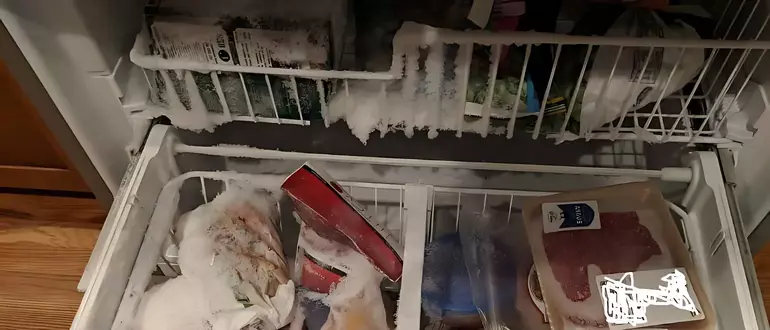
How to Fix Ice Accumulation in Your KitchenAid Refrigerator Freezer
Ice accumulation in your fridge can be a frustrating and inconvenient problem, but fortunately, there are solutions.
Check the Door Seal
One common reason for ice accumulation in your freezer is a faulty door seal. If the seal is damaged or worn out, warm air can enter the freezer, causing ice buildup.
Check the seal closing the door on a piece of paper, and the paper slides to replace the seal.
Defrost the Freezer
Another reason for ice buildup is if your freezer has not been defrosted recently. Ice can accumulate and cause blockages, making it difficult for air to circulate.
Turn off the freezer and sit with the door open for some hours. Make sure to remove any food or items not to thaw and create a mess.
Clean the Condenser Coils
Dirty or dusty condenser coils can also lead to ice accumulation in your freezer.
The coils are located at the back or bottom of the fridge and can be cleaned with a vacuum or brush.
Make sure to unplug the fridge before cleaning and avoid damaging the coils.
Check the Temperature Setting
If the temperature setting in your freezer is too low, it can cause excess moisture to freeze and create ice buildup.
Check the manual or look online to find the recommended temperature setting for your fridge and freezer. Use a thermometer to check the temperature’s accuracy.
Replace the Defrost Thermostat
If none of the above steps have solved the issue, it may be time to replace the defrost thermostat.
This part is responsible for regulating the defrost cycle in your fridge and can wear out over time.
Consult the manual or a professional technician for instructions on how to replace the thermostat.
Common Causes of Ice Accumulation in Your KitchenAid Refrigerator Freezer
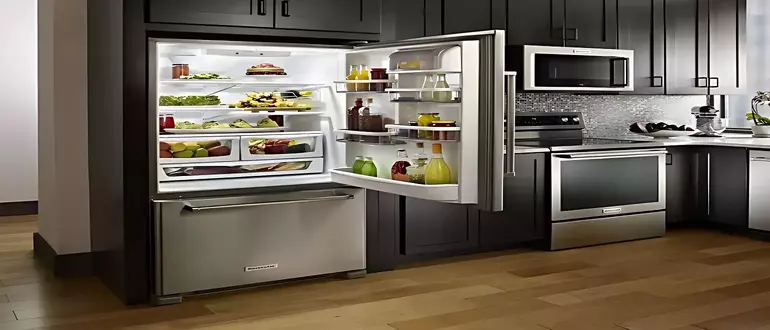
Here are some common causes of ice accumulation in your KitchenAid refrigerator freezer, explained in clear and concise language:
Faulty Door Seal:
One of the most common reasons for ice accumulation in a KitchenAid refrigerator freezer is a damaged or worn-out door seal.
If warm air is entering the freezer due to a faulty door seal, it can cause ice buildup.
Defrost System Failure:
Another common cause of ice accumulation is a failure in the defrost system. This can happen if the defrost thermostat, timer, or heater malfunctions, leading to excess ice buildup.
Low Temperature Setting:
If the temperature setting in the freezer is too low, it can cause excess moisture to freeze and create ice buildup.
It’s important to set the temperature to the recommended level to avoid this issue.
Dirty Condenser Coils:
Dirty or dusty condenser coils can also cause ice accumulation in your KitchenAid refrigerator freezer.
Over time, debris can block the coils, making it difficult for air to circulate and causing ice buildup.
Blocked Air Vents:
If the air vents inside the freezer are blocked, it can prevent proper airflow and lead to ice accumulation. Make sure to keep the vents clear of any food items or debris.
How to Diagnose Ice Accumulation Issues in Your KitchenAid Refrigerator Freezer
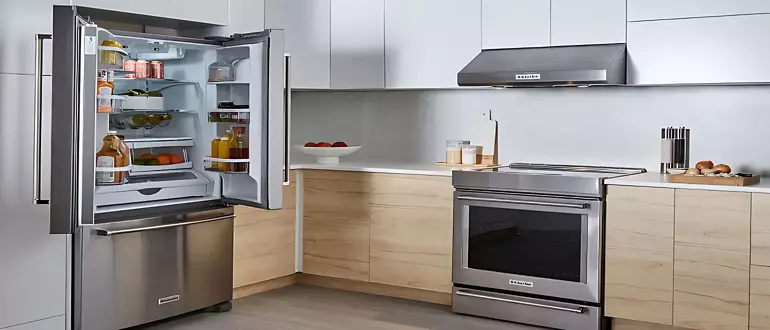
Some of the simple steps can diagnose ice accumulation issues in your KitchenAid refrigerator freezer:
Observe the Amount of Ice:
The first step in diagnosing an ice accumulation issue is to observe the amount of ice in the freezer.
A small amount of ice can not cause concern. If there is a significant buildup, it could indicate a problem.
Check the Door Seal:
Inspect the door seal for any damage or wear. If warm air is entering the freezer due to a faulty door seal, it can cause ice buildup. If the paper slides out easily, it’s time to replace the seal.
Monitor the Temperature:
Check the temperature setting in the freezer and monitor the temperature over time.
If the temperature is too low, it can cause excess moisture to freeze and create ice buildup. Make sure to set the temperature to the recommended level.
Clean the Condenser Coils:
Dirty or dusty condenser coils can also cause ice accumulation in your KitchenAid refrigerator freezer. Clean the coils with a vacuum or brush to ensure proper airflow.
Check the Defrost System:
If none of the above steps have solved the issue, it may be a problem with the defrost system.
Check the defrost thermostat, timer, and heater for any malfunctions. Consult the manual or a professional technician for instructions on how to check these parts.
DIY Solutions for Preventing and Fixing Ice Accumulation
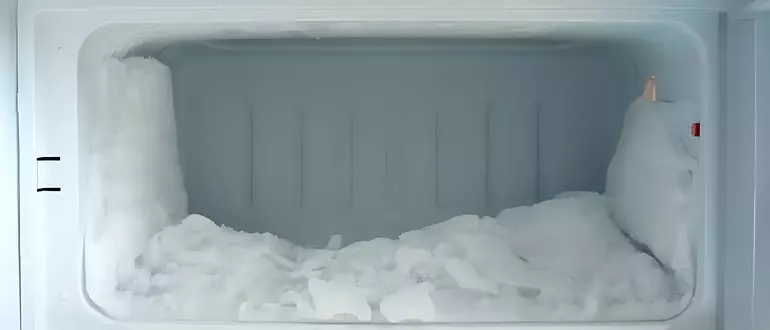
DIY solutions can prevent and fix ice accumulation in your KitchenAid refrigerator freezer:
Keep the Freezer Door Closed:
One of the simplest ways to prevent ice accumulation is to make sure the freezer door is closed tightly.
Warm air entering the freezer can cause moisture to freeze and create ice buildup.
Defrost the Freezer Regularly:
To prevent excess ice buildup regularly defrost the freezer. Turn it off to let it thaw for several hours or until all the ice melts. Make sure to remove any food or items that may thaw and create a mess.
Clean the Condenser Coils:
Dirty or dusty condenser coils can also lead to ice accumulation in your freezer. Use a vacuum or brush to clean the coils regularly, and make sure to unplug the fridge before cleaning to avoid any accidents.
Check the Temperature Setting:
The temperature setting is set the as directed. Too low can excess moisture to freeze and create ice buildup.
Replace the Defrost Thermostat:
If none of the above solutions work, it may be time to replace the defrost thermostat. This part regulates the defrost cycle in your fridge and can wear out over time.
Consult the manual or a professional technician for instructions on how to replace the thermostat.
How to Properly Maintain Your KitchenAid Refrigerator Freezer
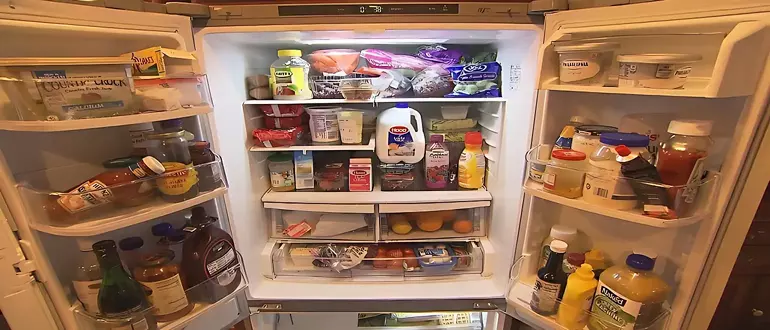
Here are some tips for properly maintaining your KitchenAid refrigerator freezer, explained in clear and concise language:
Clean the Interior Regularly:
It’s important to keep the interior of your refrigerator and freezer clean to prevent the buildup of bacteria and odors.
Use a mild detergent and warm water to wipe down the interior surfaces, and make sure to clean spills and messes as soon as possible.
Check the Door Seal:
Make sure the door seal on your freezer is in good condition and is free of any damage.
A damaged seal can cause warm air to enter the freezer, leading to ice accumulation and reduced efficiency.
Replace the Water Filter:
If your KitchenAid refrigerator has a water filter, replace it to maintain the quality of your drinking water. Follow the manufacturer’s instructions for replacement.
Clean the Condenser Coils:
Dirty or dusty condenser coils can cause your refrigerator to work harder and less efficiently.
Use a vacuum or brush to clean the coils every six months to a year, or more frequently if you have pets that shed.
Check the Temperature Settings:
Make sure the temperature settings for both the refrigerator and freezer are set to the recommended levels. This will help keep your food fresh and prevent ice buildup.
Organize Your Food:
Properly organizing your food can help improve the airflow inside your refrigerator and freezer.
Use clear containers or bags to store food, and make sure not to overcrowd the shelves or drawers.
What Does Max Ice Mean and How Does It Affect Ice Accumulation in a KitchenAid Refrigerator?
The max ice feature in kitchenaid refrigerators refers to the functionality that allows for maximum ice production within a designated timeframe. This means that the refrigerator will produce ice at a faster rate, ensuring a constant supply for your needs. It affects ice accumulation by increasing the speed at which ice is made, making it ideal for situations where a large amount of ice is required, such as parties or events.
FAQs
Can I Remove The Ice Buildup Manually?
Yes, you can manually remove the ice buildup using a plastic or wooden utensil to avoid damaging the freezer walls. You can also use a hair dryer to melt the ice quickly.
What Should I Do If The Ice Buildup Continues Even After Defrosting The Freezer?
If the ice buildup continues even after defrosting the freezer and trying the DIY solutions, it may be time to call a professional technician to diagnose and fix the issue.
How Often Should I Defrost My KitchenAid Refrigerator Freezer?
It’s recommended to defrost your freezer at least once a year, or more frequently if you notice excessive ice buildup.
Is It Safe To Use A Chemical De-Icer To Remove Ice Buildup In My Freezer?
It’s not recommended to use chemical de-icers in your freezer as they can damage the interior and may leave harmful residues. Stick to using manual methods or a hairdryer to melt the ice
Conclusion
Maintaining and fixing ice accumulation in your KitchenAid refrigerator freezer is an important part of keeping your appliance functioning properly and ensuring the quality of your food.
By following these DIY solutions and preventative maintenance tips, you can save time and money by avoiding costly repairs and extending the lifespan of your refrigerator freezer.
Remember to always consult the manufacturer’s instructions and safety precautions before attempting any repairs or maintenance.

